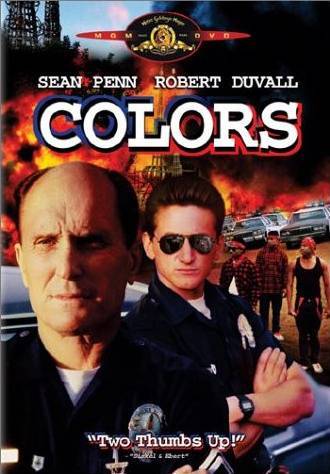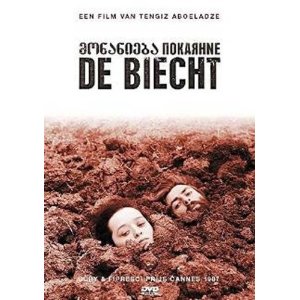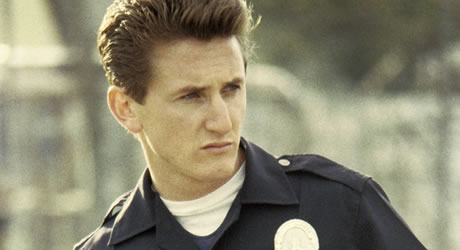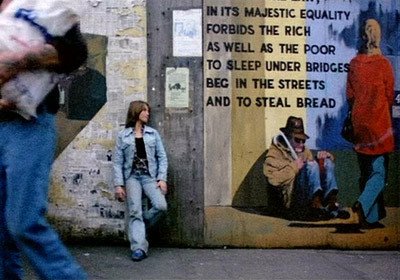From the Chicago Reader (May 6, 1988). — J.R.
COLORS
** (Worth seeing)
Directed by Dennis Hopper
Written by Michael Schiffer and Richard Dilello
With Sean Penn, Robert Duvall, Maria Conchita Alonso, Randy Brooks, Grand Bush, Don Cheadle, Glenn Plummer, and Rudy Ramos.
REPENTANCE
*** (A must-see)
Directed by Tengiz Abuladze
Written by Nana Djanelidze, Tengiz Abuladze, and Rezo Kveselava
With Avtandil Makharadze, Zeinab Botsvadze, Ketevan Abuladze, Edisher Giorgobiani, Kakhi Kavsadze, Iya Ninidze, and Merab Ninidze.
For several weeks now, I’ve been trying to get a fix on what irritates me so much about Colors. Seeing it again recently, and then seeing Repentance for the first time the next day, a few hours before I started this review, gave me the beginning of an answer, and it isn’t a pretty one. If these films can be said to represent what “social criticism” currently means in the respective cultures of the U.S. and the Soviet Union — and, after a certain amount of boiling and scraping, I think that they can — then it seems to me we’re in trouble.
It’s been estimated that over 60 million Russians have already seen Repentance, the most prominent of all the belated, post-glasnost Soviet releases — scripted in 1981-82, filmed in 1984, and apparently shelved for only two years prior to the thaw. (A year ago, it won the special jury prize at the Cannes Film Festival.) I don’t know how many Americans have seen Colors so far — in this country, judging from the weekly figures in Variety and the Chicago Tribune, dollars are worth more than people, at least in computing and defining the success of movies — but it’s been at the top of the charts, both nationally and locally, for the past couple of weeks. And it shouldn’t be surprising that Colors is now playing at two dozen theaters in the Chicago area, while Repentance is getting only a limited one-week run at the Music Box. After all, the former has Sean Penn, bullets, car chases, and wall-to-wall percussive pop music. The latter is, according to its director, “a tragic phantasmagoria, a grotesque tragicomedy, or perhaps a lyrical tragifarce,” as well as a political allegory, and only has a few moments of percussive pop music (along with quotes from Beethoven’s Ninth Symphony and Shakespeare’s 66th sonnet).
Which of these films is regarded as absolutely essential to this country, containing vital information that can’t be found elsewhere as well as artistic integrity, imagination, originality, intelligence, vitality, and serious social meaning? And which, on the other hand, is regarded as marginal and inconsequential, unworthy of extended treatment or even mention in most cases on TV and in glossy magazines — a trivial pursuit, in short, for trivial people? Two guesses.
Insofar as Colors partially exists in order to put Dennis Hopper’s directorial career back in the pink, this may be all the justification it needs, and I can only wish it well. At the same time, if anyone else had directed it, I wouldn’t be irritated by it nearly as much. For the movie represents at best a small triumph of disinterested and impersonal technique, which is apparently what the industry wants from directors now. (The alternate scenario, proposed by David Puttnam, the former head of Columbia — to wrest creative control away from stars, agents, and packagers and give it back to directors, yielding personal projects like Housekeeping and The Last Emperor — made him the most hated figure in Hollywood.)
As other reviewers have noted, Colors is a collection of loose pieces that only occasionally fit together. Nothing builds dramatically, and none of the characters can be said to grow in meaning or impact. As a look at two drug-dealing gangs in Los Angeles and the efforts of the local police in holding them at bay, the movie sustains a fairly lively surface with its steady stream of rap songs and jivey percussion on the sound track (score by Herbie Hancock), its car chases and periodic bursts of violence, its authentic-sounding lingo (such as the obsessive use of “Homes,” a nickname among gang members), its omnipresent graffiti, and its conspicuously “busy” performances from the two leads, Robert Duvall and Sean Penn, as a relatively peaceful older cop partnered with a sadistic younger cop. But what is it about, and what does it have to say?
Admittedly, continuity has never been one of Hopper’s strong points as a director; but who would have guessed that this liability would have wound up working for him in commercial terms? The discontinuous surface of Colors is quite a bit like TV, which probably helps in selling concessions as well as movie tickets: there are plenty of points when you can go out for popcorn without missing anything. And the film’s attitudes toward its two lead characters are so “balanced” that they’re virtually incoherent — or at the very least noncommittal. Bob Hodges (Duvall) is shown as kinder and wiser but less effectual; Danny McGavin (Penn) is seen as a cruel sadist who, like Dirty Harry, is more clever and effective in delivering the goods. As for the gang members, the film shows a certain amount of detail about how they work as units — how a younger recruit gets violently initiated, for instance — but virtually no interest or curiosity at all in how they function as individuals. As if to even things out, both cops and gang members are shown on separate occasions shooting the wrong people by mistake.
There is even, heaven help us, the obligatory scene where cops and concerned members of the community all sit around and ask “What can we do?” to no great effect. At least a bit of ghetto resentment — noncriminal residents tired of being pushed around by the cops — gets expressed here, which is fairly rare in American movies nowadays, but none of this is allowed to go anywhere or add up to anything. At times the movie resembles a term paper; it wears its research proudly on its sleeve, and human understanding of any kind is pointedly kept minimal — perhaps in order to preserve the spectator’s pristine voyeur status.
The script is terrible. Apparently Hopper had an uncredited hand in revising it, but it doesn’t show. As a typical example of how the movie thinks and operates, the first extended car chase, through various back alleys in East LA — very effectively shot by Haskell Wexler — has two police cars chasing after two cars full of gang members who’ve just attacked the funeral of a rival gang member with a blaze of bullets. Both of the gang cars topple and crash in a playground, and the police car containing Hodges and McGavin flips over. As they’re hanging upside down in their car, Hodges says to McGavin, “My wife says she wants to meet you. She says you can bring a date” — and the scene abruptly shifts to McGavin with a date visiting Hodges and his family. Who got killed in the last scene, and who got caught? The movie doesn’t care, and, thanks to such indifference, neither do we.
To make sure my memory wasn’t playing tricks on me, I recently took another look at Hopper’s previous film, Out of the Blue (1980). Here was proof, if any is needed, that a celebrated burnt-out case came back to establish himself as the legitimate American heir to the cinema of Nicholas Ray — a cinema of tortured lyricism and passionate rebellion that reached its fullest flower in the 50s, as if to match the action painting that was roughly contemporary with it. Hopper managed to remake Ray’s Rebel Without a Cause (the film in which Hopper made his acting debut) in terms of a working-class punk (Linda Manz), an androgynous heroine whose grim fate suggested an Americanized version of Robert Bresson’s Mouchette. Casting himself, moreover, as her dissolute father, Hopper gave himself a disturbing part that seemed to update his role as Billy in Easy Rider.
Originally hired to work on Out of the Blue solely as an actor, Hopper took over as director at the last minute. He fashioned an extraordinary movie with a minimum of time (a month of shooting, six weeks of editing) and money ($1.2 million, $780,000 of it reportedly Hopper’s own) that easily surpassed both Easy Rider (1969), and The Last Movie (1971) — his respectively overrated and underrated first two movies — as historical testimony and as aesthetic object. But very few people have ever heard of this late-blooming masterpiece, much less seen it. The fact that it belongs to that elephant graveyard of titles available on video doesn’t mean that it’s been validated by even the minimal cultural attention routinely given to every Sylvester Stallone release.
This lengthy digression helps to account for my anger when media hype tells me that I’m supposed to regard Colors as Hopper’s first significant movie since Easy Rider. (Regarding the much harder to find The Last Movie, which I haven’t looked at since its limited release in 1971, I’ve always been haunted by Nicholas Ray’s claim that the five- or six-hour rough cut was one of the great works in the American cinema.) Yet the discontinuity of Colors with Hopper’s three earlier features is part of what’s alarming about it. The project was developed by Sean Penn, who brought in Hopper as a director; without Hopper’s name in the credits, I doubt anyone would recognize his participation. But considering what happened to Out of the Blue, it’s no wonder that he’s given up.
Repentance, on the other hand, identifies itself in the credits as the last part of a trilogy. I’ve never seen a film before by the Georgian director Tengiz Abuladze — including either The Invocation (1968) or The Wishing Tree (1976), the first two parts of the trilogy — so I can’t make any comparative judgments about this movie in relation to his other work. I should also confess to a certain former bias against this movie that made me less than eager to see it. Early reports that it was an allegory about Stalinism and more interesting as a function of glasnost than a work of art, coupled with my knowledge of its running time, (150 minutes), made it seem ponderous and deadly, an unpleasant duty at best.
As it turns out, it is nothing of the sort — except for being an allegory, which is probably what scared me and my American reflexes off the most; we all know from the ways we were taught this in school that allegories are instruments of pain, not pleasure. What this prejudice misses, however, is the movie’s playful and fanciful side, which led one critic to call it “socialist surrealism.” As Abuladze pointed out in an interview last year, “Much of Repentance — not a shot or a phrase — consists of images I have seen in my dreams. I am certain that it was through dreams that my unconscious forced the story to the surface so that I would film it.”
In contrast to the dull deliberations that dog Colors at every turn — could one imagine it even having an unconscious? — as well as the reductive notions of realism that substitute surface verisimilitude for analysis, understanding, or stylistic interest, Repentance is a veritable trip through Disneyland. It is even — dare I say this, when Dennis Hopper is concerned? — a hipper, more psychedelic, and funnier movie than Colors. I won’t deny that it gets difficult and/or dull in a few spots, but there are not very many of them. Above all, Repentance offers its audience an intellectual and emotional adventure, and treats it like an equal in this undertaking. There is none of the wallpaper consistency and prosaic flatness of Colors, which keeps shoving the same ingredients at the audience from here to doomsday, always at the same hyped-up pitch.
Repentance begins and ends in a small cake shop in Georgia where a woman named Ketevan Barateli (Zeinab Botsvadze), applying icing to pastry, learns about the death of the mayor, Varlam Aravidze (Avtandil Makharadze) — a framing device that strongly implies that everything else in the film represents her idle daydream. With a great deal of pomp, overblown rhetoric, and hypocrisy, the mayor is buried. But the next morning, his son Abel (also played by Avtandil Makharadze) and daughter-in-law find his corpse propped against a tree in their garden. After much embarrassment, the corpse is reburied, only to reappear the next morning in a garden chair. Eventually the grave robber — Ketevan herself — is arrested and brought to trial, where she expresses her determination to exhume his corpse indefinitely, as often as it’s buried, in the interests of justice rather than revenge. A lengthy flashback to her childhood, which constitutes much of the remainder of the film, explains why.
As a little girl of eight, she observes his silly inauguration and speech, his words drowned out by a brass band and the slapstick complications created by a burst water main and several aides who try to combat it. Her father, Sandro (Edisher Giorgobiani), protests against the proposed destruction of an ancient church being used as a research lab, and Varlam, the mayor, seems to lend a sympathetic ear. Soon afterward, he pays Sandro a visit to look at his paintings, and praises them effusively; but not long after that, Sandro is arrested and exiled as a subversive artist. His former teacher, other associates, and eventually his wife (Ketevan Abuladze) are arrested as well, and Ketevan never sees any of them again.
Back in the courtroom, Ketevan is declared innocent, and Abel’s son Tornike (Merab Ninidze), horrified by what he has discovered, begins to have serious questions about his own father’s integrity — particularly after Abel uses his influence to have Ketevan declared insane and committed to an asylum. This eventually leads to Tornike’s suicide and Abel himself digging up his father’s body to drop it off a cliff.
Despite some of the gloomy details, a lot of this is played for laughs, and some of it’s very funny indeed. The mayor himself — a figure out of comic opera who periodically sings arias to whoever’s around — is a kind of cartoon composite of four dictators, sporting Hitler’s mustache, Mussolini’s black shirt and suspenders, Stalin’s boots and dark eyes, and Beria’s pince-nez. He typically starts off his speeches reasonably enough, only to descend gradually to maniacal rages and gibberish (“Four out of every three people are our enemies!”). His “refusal” to remain buried at the beginning and end may have a simple allegorical meaning, but that doesn’t prevent Abuladze from spinning some of this out as rather hilarious slapstick.
A few of the best scenes in the movie manage to be funny and eerie at the same time — dream images that are so suggestive and expressive that we don’t have to worry about whether we’re catching all the local references or not. (As strange as it sounds, I had nearly as much trouble following all the characters and slang references in Colors.) My favorite scene, Varlam’s visit to Barateli’s flat with his son and henchmen, begins with him appearing at the door flanked by stooges in tuxedos who are bearing a bird cage and a bouquet of red flowers; Abel, his young son, appears magically from under his cloak, and goes off to play with Ketevan. When the entourage leaves, the sense of Gogolian fantasy is even more pronounced: mayor, son, and henchmen all leap in turn from the living room window into the dark street below, and the sound of galloping horses is heard immediately after each one jumps.
The incongruous mix of details often has a radiant rightness to it that is poetic rather than reasoned out. Later, when Sandro is arrested, for example, the mayor’s henchmen who arrive at his flat are dressed in suits of armor and carry spears; while Sandro is preparing to leave and some of his paintings are being carried out, one of the henchmen picks out Chaplin’s theme to City Lights on the piano. (Time and period are often as deliberately unfixed in this movie as a sense of space.) Interpolated dreams or fantasy interludes become continuations of the plot rather than interruptions: when late in the film Abel finds himself confessing his dual nature to a priest who proves to be alternately his dead father and himself, the dialogue is a direct extension of scenes with his family and in the courtroom, and the same prop — a skinned fish — is also carried over.
As Abuladze has pointed out, the figure of Abel is “even more dangerous” than Varlam, and insofar as he, like Abuladze’s audience, lives in the present, he is more important as well. So to say that this is a movie about Stalinism, while not a falsehood, is a simplification. The movie is a complex yet direct gesture of mourning for the corpse of the Stalinist period, and an inquiry into the ways in which it can or can’t be buried. A major point to be made about its fanciful methods is that its concrete concerns and dreamlike details aren’t in any sort of conflict; the latter become the perfect and practical medium of the former. Poetry with the ring of necessity, it plunges into reality with specific aims in mind — perhaps most specifically, to wake from the nightmare of history with a distinct recollection of what happened and to try to determine why.
In this respect, it becomes an object lesson for a piece of exploitation like Colors that purports to bear witness on its own — a movie that naively assumes that simply to bring up a subject is tantamount to dealing seriously with it. But whom is Colors supposed to be educating, and about what, and to what end? What practical tools is it offering, apart from sounds and images to nod off to? A little bit of dreams and fantasy — anybody’s dreams, anybody’s fantasies — might give it more of a soul and a purpose, something denser than a stream of rap tunes and car crashes that are supposed to give an audience an illusion of being involved — involved in an issue that, to all intents and purposes, hasn’t even been defined.
An exclusive diet of realism as a medium for serious art and/or social discourse is part of the problem. (Could this be why the French took Poe and Faulkner seriously long before we did, and catch the social meanings in Jerry Lewis movies that most Americans are blind to?) After rightly declaring for decades how utterly boring Soviet socialist realism is, why can’t we come up with something more interesting that’s socially useful ourselves? Why, for every truthful scene or detail in a Platoon or a Wall Street, do we have to put up with yards of childish comic-book rhetoric? Why is Broadcast News serious only when it deals with newscasters, and helpless when it has to deal with the news? Or is all that we can even hope to get from “serious” movies some form of noncommittal journalism, carefully calculated to change precisely nothing?







